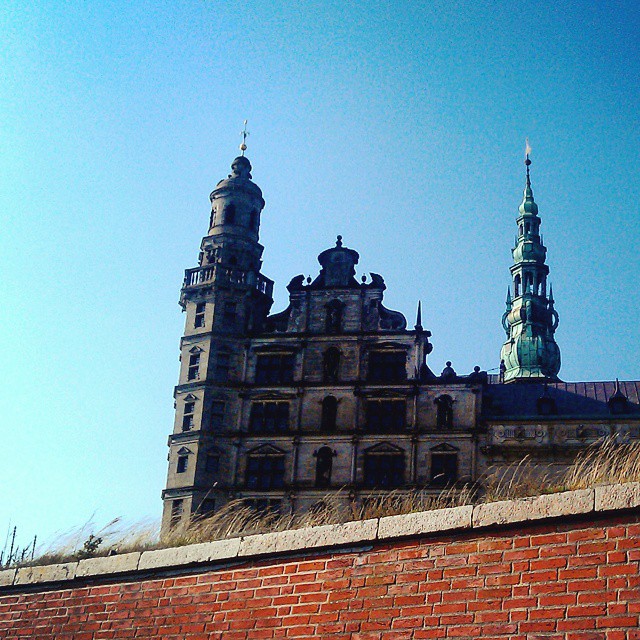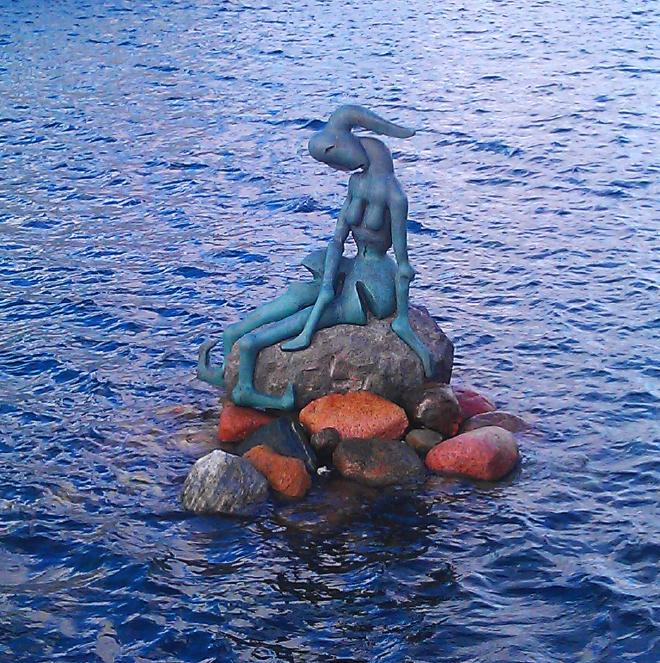Denmark Diaries: Travelling

I’ve been travelling a lot in the last few weeks, both in the city and in Zealand.
Firstly, my best friend M. was visiting the city for a few days. In addition to the “traditional” sightseeing tour, he even had a day at the beach while I had to go to university. In the evening, we went to the university’s “Friday Bar”, a Danish institution.
Madame also came to Copenhagen the following week. I had organised a bike for her and we cycled comfortably through the city together, enjoying the sun and the light sea breeze. We had been to Copenhagen together before, had already seen the “main” sights and now had more time for the more hidden things. For example, we visited the genetically modified Little Mermaid - a modern statue that is much less aesthetic, but closer to Hans-Christian Andersen’s fairy tale. The genetically modified version is located on Langeliniekaj, which is actually very close to the “original”, but the hordes of tourists on the hop-on hop-off buses usually don’t get there. When we were there, there were only three other people besides us looking at the sculpture. In addition to the short bike tour through the city, there was also plenty of time for a cosy coffee in the sun, a pizza in the park behind the National Gallery and a day trip to the Louisiana Museum, where this time (on a Sunday) it was relatively crowded. The museum itself was fine, but there was a queue of almost half an hour for two cups of coffee in the café.

Last weekend, I finally travelled further out of Copenhagen for the first time - the plan was a short shore excursion to Helsingør in the north of Zealand. It takes just under an hour by train from Copenhagen to get to the narrowest part of the Öresund and into the fresh sea breeze. On a cloudless and sunny autumn day, I could already see numerous sailors on the Öresund during my train journey.
Helsingør used to be relatively important for Denmark, as the Öresund was monitored from here and the Sund customs duty was levied - which at times accounted for more than half of Denmark’s state revenue. Meanwhile, the city is relatively sleepy - I first strolled through the old town before making my way to Kronborg Palace, the main attraction. In contrast to Copenhagen, where most supermarkets are open on Sundays, almost all the shops and even some bakeries and restaurants were closed here. The old town is pretty much the cliché of Denmark: lots of low houses, all brightly painted. But I am all the more surprised when I turn off towards the castle at one of the larger squares and suddenly walk past the local strip club - also housed in an old yellow half-timbered building. The proximity to Sweden (there is a direct ferry connection) is noticeable everywhere: Everywhere you go, the prices are noted in Danish and Swedish kroner. Also, Helsingør seems to make a good living from selling alcohol: It’s cheaper than in Sweden and apparently a nice attraction for Swedish day trippers.
As I walk through the old town, I take a quick look at St Olai’s Cathedral Church (relatively large on the outside with lots of brick, cosy on the inside with lots of wood, gold and candles) and the Carmelite monastery near St Mariæ. There is a noticeable amount of German in the churches - in the castle church, the pulpit is completely decorated with German quotations from the Bible. This is one of the things I hadn’t expected before I came to Denmark: Germany’s influence as a big neighbour to the south is always noticeable. There have been German immigrants who were particularly important for Denmark - one of the kings even brought his entire administrative elite from Germany. Conversely, I often have the feeling that we Germans are rather distanced from Denmark: In my mind, Denmark is first and foremost a Scandinavian country and not a neighbouring country of Germany (which even at one point had expanded to just outside the city limits of Hamburg).
After a tour of the old town, I finally make my way to Kronborg Castle, which was also a garrison for monitoring the Öresund for more than 500 years. Sweden is clearly visible from here. Kronborg Castle actually became famous because of another story: it is the castle “Elsinore” (based on the city name Helsingør), where Shakespeare’s Hamlet is set. However, the Danish prince Hamlet actually comes from Jutland (the part of Denmark that lies to the north of Germany) and has therefore never been to Helsingør, which is in the heart of Zealand (the large island in the east on which Copenhagen is also located). However, the characters of Rosencrantz and Guildenstern are based on two Danish noblemen from Shakespeare’s time. Of course, Hamlet merchandise has broken out in the castle itself - who hasn’t always wanted a “To be or not to be” t-shirt? In August, there are alternating Hamlet guest performances at the palace every year - in recent years also with the production of the Berlin Schaubühne with Lars Eidinger or from the Globe Theatre in London. For the numerous Hamlet tourists, an empty Hamlet grave has also been dug nearby in Marienlyst Castle.
At the castle, the casemates are particularly interesting: after a few explanations at the beginning, you simply walk into the rather sparsely lit underground vaults. It is relatively dark when not using a torch or light from a mobile phone. I am only very rarely pointed to the “official” route and can explore much of it yourself. Holger Danske, who is the Danish equivalent of the Barbarossa legend, is also said to rest in the casemates of Kronborg Castle: Holger Danske is said to have lived around the time of Charlemagne and first fought against him, then alongside him. At some point, he fell into a deep sleep, from which he is said to have only awoken when Denmark was in danger. In the 17th century, however, when Denmark lost a series of wars and had to cede large parts of its territory to Sweden, this worked out rather mediocre.
But the day was too beautiful to just stumble through musty casemates - the warming autumn sun and the fresh sea breeze could be enjoyed very well on the small beach directly in front of the castle. The locals also took the opportunity to eat fish and drink beer in the afternoon sun at the Kulturværftet. (My choice: Americano and a book in the pedestrian area)